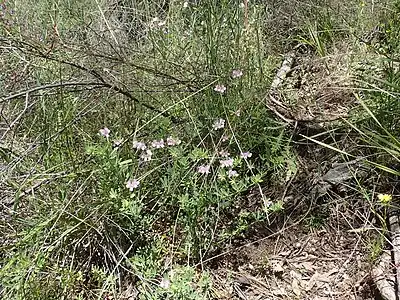| Lotus australis | |
|---|---|
.jpg.webp) | |
| Illustration by Henry Cranke Andrews | |
| Scientific classification | |
| Kingdom: | Plantae |
| Clade: | Tracheophytes |
| Clade: | Angiosperms |
| Clade: | Eudicots |
| Clade: | Rosids |
| Order: | Fabales |
| Family: | Fabaceae |
| Subfamily: | Faboideae |
| Genus: | Lotus |
| Species: | L. australis |
| Binomial name | |
| Lotus australis | |
 | |
| Occurrence data from AVH | |
Lotus australis, known by its common name of austral trefoil, is a small, spreading herb from the family Fabaceae. It normally grows to around 30–50 cm in height and is native to Australia.[1]
Leaves are of a trifoliate shape and are small, with a light green colour. During spring, the plant bursts into beautiful massed displays of white pea flowers. In summer, these are replaced with stiff, tubular beans, which explode when they dry, releasing multiple small, black legume seeds. Austral trefoil is easily propagated from these seeds, by soaking the seeds in hot water overnight before sowing. This mimics the heat of a bushfire, which is a contributing factor in germination in the wild.[2]
Lotus australis is one of just a few plants in which the cyanogenic glucoside known as lotaustralin naturally occurs.[3]
Gallery
 Habitat
Habitat Inflorescence
Inflorescence
References
- ↑ "Plants of the Adelaide plains and hills". Library of South Australia. Retrieved 21 March 2011.
- ↑ "The Native Plants of Adelaide". Department for Environment and Heritage. Archived from the original on 15 March 2011. Retrieved 21 March 2011.
- ↑ "Lotaustralin: sc-207835". santa cruz biotechnology, inc. Retrieved 16 April 2011.